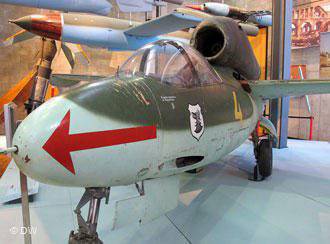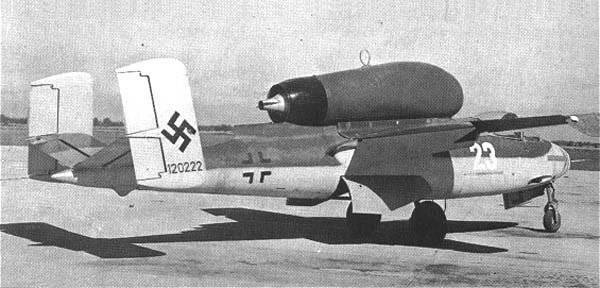Return to the homeland of the fighter He-162
 Recently, one of the surviving fighter jets, the He-162, arrived at the Technical Museum of Berlin. In all, no more than ten vehicles of this project survived.
Recently, one of the surviving fighter jets, the He-162, arrived at the Technical Museum of Berlin. In all, no more than ten vehicles of this project survived.About a fighter jet it is known that he only went up to the sky several times and was captured by the Allied forces at the airfield in the town of Lek. The plane was taken to England, where he was dismantled and tested, after some time he got to Canada, where he was exhibited in the museum of the city of Ottawa. After a few years in the collection to a British citizen, he was still with him, but this summer the collector sold the He-162 fighter to the German Technical Museum.
On board the aircraft, the paint can be seen to the naked eye with paint “before turning on the engine, push the nozzle to the“ S ”mark, and a vertical line is drawn on top, at the end of which the letter“ S ”is drawn. There are inscriptions of tire pressure, there are also instructions on where to find the wiring. The plane is light green in color, but this is not the original color, the aircraft was repainted in 60's.
The fighter is a bit like a fish - an elongated bow section, a wide and thick belly, in which two tanks for aviation gasoline are installed, wings are reduced and wide - the length of the entire 9 plane is meters, the width of the wings is 7 meters. A jet engine is mounted on top, it looks like a black big pipe. Therefore, in order for the vertical tail not to burn with a flame from the engine nozzle, the tail was executed in a forked v-shape.

History The fighter begins in 1944. In Germany, realizing that the newest weapons can change the course of the war, they are constantly looking for and embody new ideas. So, one of the ideas was the creation of a combat fighter of mass production “volksjager” - in the colloquial phrase “people's fighter”.
The plane, in theory, should be made of the most inexpensive materials using low-skilled workers - prisoners of war.
At the end of 1944, at the request of the military department, the Technical Department prepared and sent out the basic project requirements to the leading German aircraft manufacturers - Junkers, Messrschmitt, Focke-Wolf, Heinkel, Blom und Voss, Arado, Fieseler.
Inexpensive and mass aircraft on request should have:
- one turbojet VMW-003 engine;
- have a weight of no more than 2000 kg;
- have a speed of about 750 km / h;
- flight duration at least 30 minutes;
- the length of the run is not more than 500 meters;
- to have weapons - one or two 30-mm guns.
To prepare the draft aircraft took the shortest time - two weeks! And the aircraft had to go into mass production according to the same requirements in 90 days.
The designers of leading German aircraft manufacturing companies known at that time sharply condemned the very idea of the project, sensibly reasoning that it is better to build proven aircraft, for example, the same Me-262, than to start something new that still needs to be tested and completed. In response to these presentations, the technical department reduced the time to prepare the project for almost another week.
On preliminary consideration of applications there was a difficult situation:
- "Messerschmitt" did not even engage in the project - refused;
- Focke-Wolf provided something unreal and difficult to implement, the project was rejected;
- “Arado” did not meet the specified limits, the project was rejected;
- “Heinkel” offered its project, which was considered not feasible;
- “Blom und Voss” was recognized as the only one whose project somehow fit the specified requirements.
A representative of the Heinkel company objected to the decision and argued that the calculations and flight characteristics carried out by the commission and their own, are very different and are carried out according to a different methodology. Companies gave time to rework the project.
As a result, after several hard days considering the projects of Heinkel and Blom und Voss, the project of the latter was finally rejected. But even at the final meeting of the commission, the project of Heinkel was not finally approved.
But this did not affect the decision of Goering to approve the start of mass production of the aircraft "volksjager".

In Heinkel, since the summer of 1944, the development of a similar aircraft was already underway - an unpretentious Spitz jet aircraft (translated as Sparrow) was designed, and this became the basis for the design of a combat fighter. The "Spitz" installed the engine VMW-003 and tested the flight capabilities of the He-219V-14.
Although the project of Heinkel was not chosen by the commission, the designers worked day and night, trying to bring the project “Spitz” to the requirements of the commission. As a result, due to political reasons rather than aircraft readiness, the 1073 project went into mass production. It was decided to produce a thousand aircraft per month.
Initially, the Heinkel aircraft was assigned the number He.500, but to conduct reconnaissance over the territory controlled by the Soviet troops, the Technical Department changed the number to He.162 (originally this number was from the Messerschmitt aircraft). At the same time, the aircraft receives the name "Salamander".
The fact that all stages of aircraft development took place simultaneously - designing drawings, preparing a prototype and preparing for mass production - in the history of aircraft construction and aviation is unparalleled.
The prototype model of the He.162-V1 took off into the sky at the beginning of December 1944, during which he, flying 20 minutes and typing 6000 meters, developed the speed of 835 km / h. But due to constant failures in tests, miscalculations in the drawings and failures on the military front, the plane did not go into series. A total of about 200 machines were created.
Fighter "He.162" was not for beginners. Due to the original installation of the engine on the plane, it became unstable in pitch. The machine did not tolerate abrupt control, one of the first rules for controlling this machine among the German pilots of the time was - always gently and smoothly operate the pen, without abrupt movements, do not make quick maneuvers. Even experienced pilots underwent initial retraining; one can imagine the unrealistic training of 16-20-year-olds at an accelerated pace to control and combat the use of a fighter.
The main characteristics of "He.162":
- wing span 7 meters;
- length 9 meters;
- height 2,6 meter;
- weight 2600 kg;
- VMW-003-1 engine;
- speed 900 km / h;
- range 950 km;
- ceiling 12 000 m;
- crew one person;
- armament: two 20-mm guns, 240 rounds of ammunition.
Information